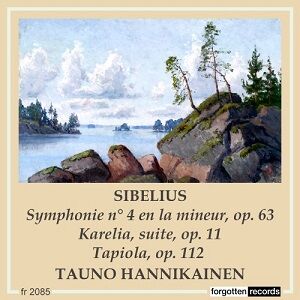
Jean Sibelius (1865-1957)
Symphony No. 4 in A minor, Opus 63 (1911)
Karelia Suite, Opus 11 (1893)
Tapiola, Opus 112 (1926)
USSR Radio Symphony Orchestra (symphony); Sinfonia of London (Karelia); London Symphony Orchestra (Tapiola)/Tauno Hannikainen
rec. 1958/9
Forgotten Records FR2085 [67]
Playing the symphony first, I was disappointed at the lack of menace or even tension. The general effect is too relaxed, laid-back and uninvolved. Instead of a grim melancholy, I feel merely a half-hearted sadness.
The playing is fine, neat and elegant, tempos feel right, but this adds up to nowhere near the powerful experience one should expect. The scherzo suffers least, until the Doppio più lento, where oboe and clarinet introduce a new theme, met with a sforzando augmented fourth from violins and violas. Here the required bite at the sforzando is missing. The slow movement has little mystery or bleakness and the finale is again slack, with no inexorable feeling. Thus, one of the most profound twentieth-century symphonies comes over as civilised and underwhelming. Incidentally, this performance was originally on Melodiya.
In his performance of the Karelia Suite (originally on Everest, then HMV, then World Record Club) Hannikainen takes a fairly relaxed view, though here it is not nearly so detrimental as in the symphony. I don’t care for the abrupt faster tempo at the introduction of the main theme in its entirety. In the score, the marking at this point is actually Meno.
First released on Everest, then world Record Club, Tapiola is the real surprise on this disc. Sibelius’s description must be quoted here:
Wide-spread they stand, the Northland’s dusky forests
Ancient, mysterious, brooding savage dreams;
Within them dwells the Forest’s mighty God,
And wood-sprites in the gloom weave magic secrets.
The first eight or nine minutes are played beautifully and then the performance erupts into violence. Just as I had given up expecting any real venom in Hannikainen’s Sibelius, I was startled and thrilled by that feeling of elemental terror which is such a necessary factor in this frighteningly vivid evocation of the Finnish forest and the malevolent spirits (“brooding savage dreams”) which dwell within. It must be said that Hannikainen elicits real spikiness in the earlier scherzando section.
As far as I can discover, the Finnish cellist and conductor Tauno Hannikainen (who died in 1968) made few recordings, mostly of Sibelius.* He conducted at the composer’s funeral service. The recordings are remarkably good, but there is absolutely no documentation – simply a folded page with a beautiful picture on the cover but completely blank inside.
Philip Borg-Wheeler
*With regard to this, please see Chris Howell’s article about Tauno Hannikainen which contains considerable detail and a different view of Hannikainen’s Sibelius recordings, as does Jonathan Woolf’s review. (Ed.)
| Availability |  |


















